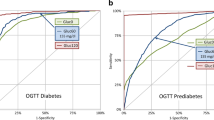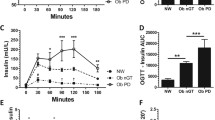Abstract
Purpose
Obese adults with normal glucose tolerance (NGT) but with 1-hour post-load plasma glucose (1hPG) ≥ 155 mg/dl are at higher risk of developing type 2 diabetes (T2D) and cardiometabolic complications. Little information is available for the pediatric population, where recently, a lower cutoff, 132.5 mg/dl, has been suggested as being more sensitive to identify subjects at risk of T2D. Our aim was to assess whether obese Caucasian youth with 1hPG ≥ 132.5 mg/dl have worse insulin sensitivity and secretion and a worse cardiometabolic profile compared to obese youth with 1hPG < 132.5 mg/dl.
Methods
Medical records of 244 (43% male; age: 11.1 ± 2.7years) overweight/obese children and adolescents, who had undergone an oral glucose tolerance test (OGTT), were retrieved. Anthropometric and biochemical data were collected from the hard copy archive. Indexes of insulin resistance (HOMA-IR), insulin sensitivity (WBISI), and insulin secretion (Insulinogenic Index, Disposition Index) were calculated.
Results
Of the 244 records analyzed, 215 fulfilled criteria for NGT and had complete biochemical data. Among NGT patients, 42 (19.5%) showed 1hPG ≥ 132.5 mg/dL (high-NGT), while the remaining had 1hPG < 132.5 mg/dL (low-NGT). The high-NGT group showed a higher male prevalence (59.5 vs 37%), lower Disposition Index (0.54 [0.39–0.71] vs 0.79 [0.47–1.43]), and WBISI (0.24 [0.18–0.35] vs 0.33 [0.23–0.50]) than the low-NGT group. High-NGT subjects also showed a trend towards lower HDL-cholesterol and higher triglycerides/HDL-cholesterol ratio (2.13 [1.49–3.41] vs 1.66 [1.24–2.49]).
Conclusions
In overweight/obese NGT Caucasian youth a 1hPG ≥ 132.5 mg/dL was able to identify those with impaired insulin sensitivity and secretion and a trend towards a worse cardio-metabolic profile, a group likely at risk for future T2D.


Similar content being viewed by others
References
Ogden CL, Carroll MD, Kit BK, Flegal KM (2014) Prevalence of childhood and adult obesity in the United States, 2011–2012. JAMA 311:806–814
Dabelea D, Mayer-Davis EJ, Saydah S et al (2014) Prevalence of type 1 and type 2 diabetes among children and adolescents from 2001 to 2009. JAMA 311:1778–1786
Kahn SE (2003) The relative contributions of insulin resistance and beta-cell dysfunction to the pathophysiology of Type 2 diabetes. Diabetologia 46:3–19
Nathan DM, Davidson MB, DeFronzo RA et al (2007) Impaired fasting glucose and impaired glucose tolerance: implications for care. Diabetes Care 30:753–759
Coutinho M, Gerstein HC, Wang Y, Yusuf S (1999) The relationship between glucose and incident cardiovascular events: a metaregression analysis of published data from 20 studies of 95,783 individuals followed for 12.4 years. Diabetes Care 22:233–240
The DECODE study group (2001) Glucose tolerance and cardiovascular mortality comparison of fasting and 2-hour diagnostic criteria. Arch Intern Med 161:397–404
Amutha A, Mohan V. Diabetes complications in childhood and adolescent onset type 2 diabetes—A review. J Diabetes Complications 2016
Bacha F, Gidding SS (2016) Cardiac abnormalities in youth with obesity and type 2 diabetes. Curr Diab Rep 16:62
Abdul-Ghani MA, Williams K, DeFronzo RA, Stern M (2007) What is the best predictor of future type 2 diabetes? Diabetes Care 30:1544–1548
Abdul-Ghani MA, Abdul-Ghani T, Ali N, Defronzo RA (2008) One-hour plasma glucose concentration and the metabolic syndrome identify subjects at high risk for future type 2 diabetes. Diabetes Care 31:1650–1655
Abdul-Ghani MA, Lyssenko V, Tuomi T, Defronzo RA, Groop L (2009) Fasting versus postload plasma glucose concentration and the risk for future type 2 diabetes: results from the botnia study. Diabetes Care 32:281–286
Alyass A, Almgren P, Akerlund M et al (2014) Modelling of OGTT curve identifies 1 h plasma glucose level as a strong predictor of incident type 2 diabetes: results from two prospective cohorts. Diabetologia 58:87–97
Jagannathan R, Sevick MA, Li H et al (2015) Elevated 1-hour plasma glucose levels are associated with dysglycemia, impaired beta-cell function, and insulin sensitivity: a pilot study from a real world health care setting. Endocr 52:172–175
Succurro E, Marini MA, Arturi F et al (2009) Elevated one-hour post-load plasma glucose levels identifies subjects with normal glucose tolerance but early carotid atherosclerosis. Atherosclerosis 207:245–249
Bianchi C, Miccoli R, Trombetta M et al (2013) Elevated 1-hour postload plasma glucose levels identify subjects with normal glucose tolerance but impaired β-cell function, insulin resistance, and worse cardiovascular risk profile: the GENFIEV study. J Clin Endocrinol Metab 98:2100–2105
Sciacqua A, Miceli S, Carullo G et al (2011) One-hour postload plasma glucose levels and left ventricular mass in hypertensive patients. Diabetes Care 34:1406–1411
Sciacqua A, Miceli S, Greco L et al (2011) One-hour postload plasma glucose levels and diastolic function in hypertensive patients. Diabetes Care 34:2291–2296
Sesti G, Hribal ML, Fiorentino TV, Sciacqua A, Perticone F (2014) Elevated 1 h postload plasma glucose levels identify adults with normal glucose tolerance but increased risk of non-alcoholic fatty liver disease. BMJ open diabetes Res care 2:e000016
Orencia AJ, Daviglus ML, Dyer AR, Walsh M, Greenland P, Stamler J (1997) One-hour postload plasma glucose and risks of fatal coronary heart disease and stroke among nondiabetic men and women: The Chicago Heart Association Detection Project in Industry (CHA) study. J Clin Epidemiol 50:1369–1376
Bergman M, Chetrit A, Roth J, Jagannathan R, Sevick M, Dankner R (2016) One-hour post-load plasma glucose level during the OGTT predicts dysglycemia. Diabetes Res Clin Pract 120:221–228
Tfayli H, Jung Lee S, Bacha F, Arslanian S (2011) One-hour plasma glucose concentration during the OGTT: what does it tell about β-cell function relative to insulin sensitivity in overweight/obese children? Pediatr Diabetes 12:572–579
Kim JY, Goran MI, Toledo-Corral CM, Weigensberg MJ, Choi M, Shaibi GQ (2013) One-hour glucose during an oral glucose challenge prospectively predicts β-cell deterioration and prediabetes in obese hispanic youth. Diabetes Care 36:1681–1686
Manco M, Miraglia Del Giudice E, Spreghini MR et al (2012) 1-hour plasma glucose in obese youth. Acta Diabetol 49:435–443
Cacciari E, Milani S, Balsamo A et al (2014) Italian cross-sectional growth charts for height, weight and BMI (2 to 20 year). J Endocrinol Invest 29:581–593
Maffeis C, Banzato C, Talamini G (2008) Waist-to-height ratio, a useful index to identify high metabolic risk in overweight children. J Pediatr 152:207–213
Biro FM (2007) Puberty. Adolesc Med State Art Rev 18:425–433
World Health Organization (1980) WHO Expert Committee on Diabetes Mellitus: second report. World Health Organ Tech Rep Ser 646:1–80
Matthews D, Hosker J, Rudenski A, Naylor B, Treacher D, Turner R (1985) Homeostasis model assessment: insulin resistance and beta-cell function from fasting plasma glucose and insulin concentrations in man. Diabetologia 28:412–419
Stumvoll M, Mitrakou a, Pimenta W et al (2000) Use of the oral glucose tolerance test to assess insulin release and insulin sensitivity. Diabetes Care 23:295–301
Phillips DI, Clark PM, Hales CN, Osmond C (1994) Understanding oral glucose tolerance: comparison of glucose or insulin measurements during the oral glucose tolerance test with specific measurements of insulin resistance and insulin secretion. Diabet Med 11:286–292
Arslanian SA, Saad R, Lewy V, Danadian K, Janosky J (2002) Hyperinsulinemia in African-American children: decreased insulin clearance and increased insulin secretion and its relationship to insulin sensitivity. Diabetes 51:3014–3019
Abdul-Ghani MA, Lyssenko V, Tuomi T, Defronzo RA, Groop L (2010) The shape of plasma glucose concentration curve during OGTT predicts future risk of type 2 diabetes. Diabetes Metab Res Rev 26:280–286
Unwin N, Shaw J, Zimmet P, Alberti KGMM (2002) Impaired glucose tolerance and impaired fasting glycaemia: the current status on definition and intervention. Diabet Med 19:708–723
Gerstein HC, Santaguida P, Raina P et al (2007) Annual incidence and relative risk of diabetes in people with various categories of dysglycemia: a systematic overview and meta-analysis of prospective studies. Diabetes Res Clin Pract 78:305–312
Bergman M, Chetrit A, Roth J, Dankner R (2016) One-hour post-load plasma glucose level during the OGTT predicts mortality: observations from the Israel Study of glucose intolerance, obesity and hypertension. Diabet Med 33:1060–1066
De Giorgis T, Marcovecchio ML, Giovanni ID et al (2014) Triglycerides-to-HDL ratio as a new marker of endothelial dysfunction in obese prepubertal children. Eur J Endocrinol 170:173–180
Di Bonito P, Valerio G, Grugni G et al (2015) Comparison of non-HDL-cholesterol versus triglycerides-to-HDL-cholesterol ratio in relation to cardiometabolic risk factors and preclinical organ damage in overweight/obese children: the CARITALY study. Nutr Metab Cardiovasc Dis 25:489–494
Marini MA, Succurro E, Frontoni S et al (2012) Insulin sensitivity, β-cell function, and incretin effect in individuals with elevated 1-hour postload plasma glucose levels. Diabetes Care 35:868–872
Marcovecchio ML, Florio R, Verginelli F et al (2016) Low AMY1 gene Copy number is associated with increased body mass index in prepubertal boys. PLoS ONE 11:e0154961
Author information
Authors and Affiliations
Corresponding author
Ethics declarations
Conflict of interest
The authors declare that they have no conflict of interest.
Rights and permissions
About this article
Cite this article
Marcovecchio, M.L., Bagordo, M., Marisi, E. et al. One-hour post-load plasma glucose levels associated with decreased insulin sensitivity and secretion and early makers of cardiometabolic risk. J Endocrinol Invest 40, 771–778 (2017). https://doi.org/10.1007/s40618-017-0638-6
Received:
Accepted:
Published:
Issue Date:
DOI: https://doi.org/10.1007/s40618-017-0638-6




